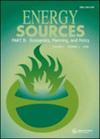Identifying optimal geographic locations for hybrid concentrated solar biomass (HCSB) power plants in Alberta and Ontario, Canada
IF 2.2
4区 工程技术
Q3 ENERGY & FUELS
Energy Sources Part B-Economics Planning and Policy
Pub Date : 2023-06-27
DOI:10.1080/15567249.2023.2229320
引用次数: 0
Abstract
ABSTRACT Solar thermal and biomass hybridization combine two energy sources that complement one another seasonally and diurnally, overcoming their respective disadvantages. In the current research, the feasibility of locating a new medium capacity (5–150 Mwe) hybrid concentrated solar biomass power plant is investigated in Alberta and Ontario. To address the above-mentioned goal, three critical criteria are considered to find the most suitable region. The amount of direct normal irradiation and the biomass feedstock in 50 km and 100 km radii are analyzed in different regions in Ontario and Alberta. The third factor is the distance to the substations. According to the results, although it is difficult to justify developing a hybrid concentrated solar biomass power plant in Ontario, at least five locations in Alberta meet the aforementioned criteria. By concentrating on substations located near natural gas power plants, Calgary, with four natural gas power plants, can be regarded as the most suitable region. According to the findings, we identified that by establishing a 100 Mwe hybrid concentrated solar biomass power plant that requires 359,478 tons of forestry biomass and costs between 3.7 and 4.9 mCAD/Mwe, about 5% of Calgary’s total electricity consumption would be met while reducing CO2 emissions by 32 tons.确定混合聚光太阳能生物质(HCSB)发电厂在加拿大阿尔伯塔省和安大略省的最佳地理位置
本文章由计算机程序翻译,如有差异,请以英文原文为准。
求助全文
约1分钟内获得全文
求助全文
来源期刊

Energy Sources Part B-Economics Planning and Policy
ENERGY & FUELS-
CiteScore
6.80
自引率
12.80%
发文量
42
审稿时长
6-12 weeks
期刊介绍:
12 issues per year
Abstracted and/or indexed in: Applied Science & Technology Index; API Abstracts/Literature; Automatic Subject Index Citation; BIOSIS Previews; Cabell’s Directory of Publishing Opportunities in Economics and Finance; Chemical Abstracts; CSA Aquatic Science & Fisheries Abstracts; CSA Environmental Sciences & Pollution Management Database; CSA Pollution Abstracts; Current Contents/Engineering, Technology & Applied Sciences; Directory of Industry Data Sources; Economic Abstracts; Electrical and Electronics Abstracts; Energy Information Abstracts; Energy Research Abstracts; Engineering Index Monthly; Environmental Abstracts; Environmental Periodicals Bibliography (EPB); International Abstracts in Operations Research; Operations/Research/Management Science Abstracts; Petroleum Abstracts; Physikalische Berichte; and Science Citation Index.
Taylor & Francis make every effort to ensure the accuracy of all the information (the "Content") contained in our publications. However, Taylor & Francis, our agents, and our licensors make no representations or warranties whatsoever as to the accuracy, completeness, or suitability for any purpose of the Content. Any opinions and views expressed in this publication are the opinions and views of the authors, and are not the views of or endorsed by Taylor & Francis. The accuracy of the Content should not be relied upon and should be independently verified with primary sources of information. Taylor & Francis shall not be liable for any losses, actions, claims, proceedings, demands, costs, expenses, damages, and other liabilities whatsoever or howsoever caused arising directly or indirectly in connection with, in relation to, or arising out of the use of the Content. Terms & Conditions of access and use can be found at http://www.tandfonline.com/page/terms-and-conditions .
 求助内容:
求助内容: 应助结果提醒方式:
应助结果提醒方式:


